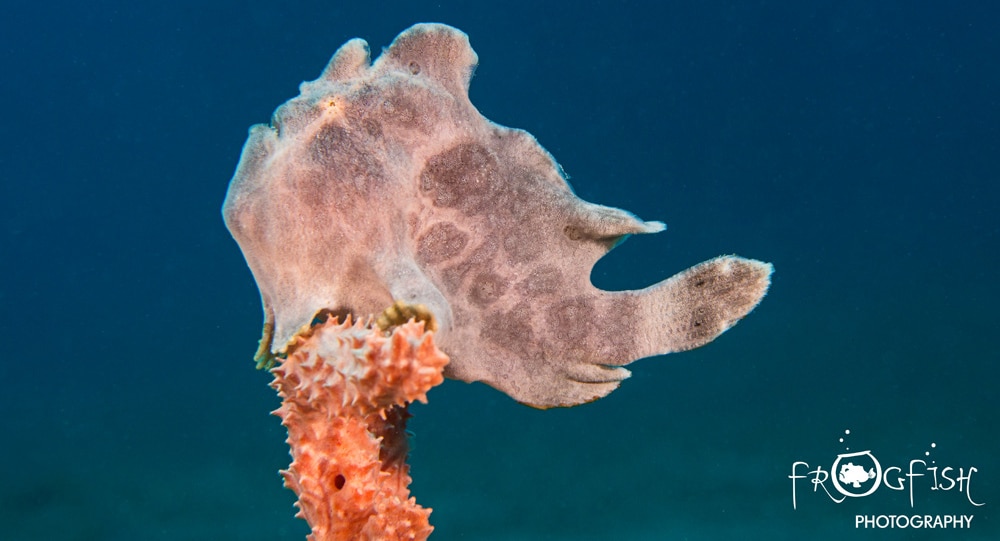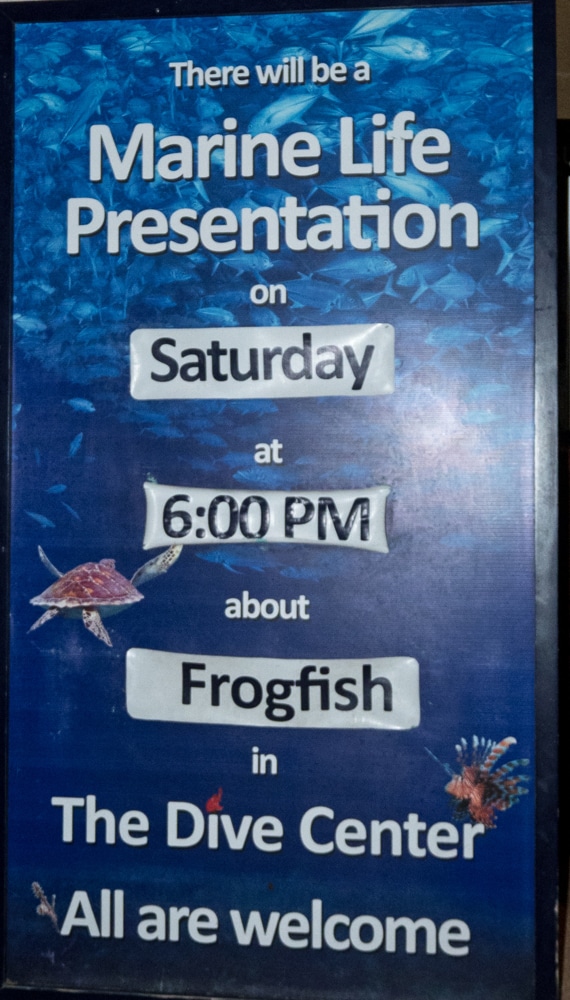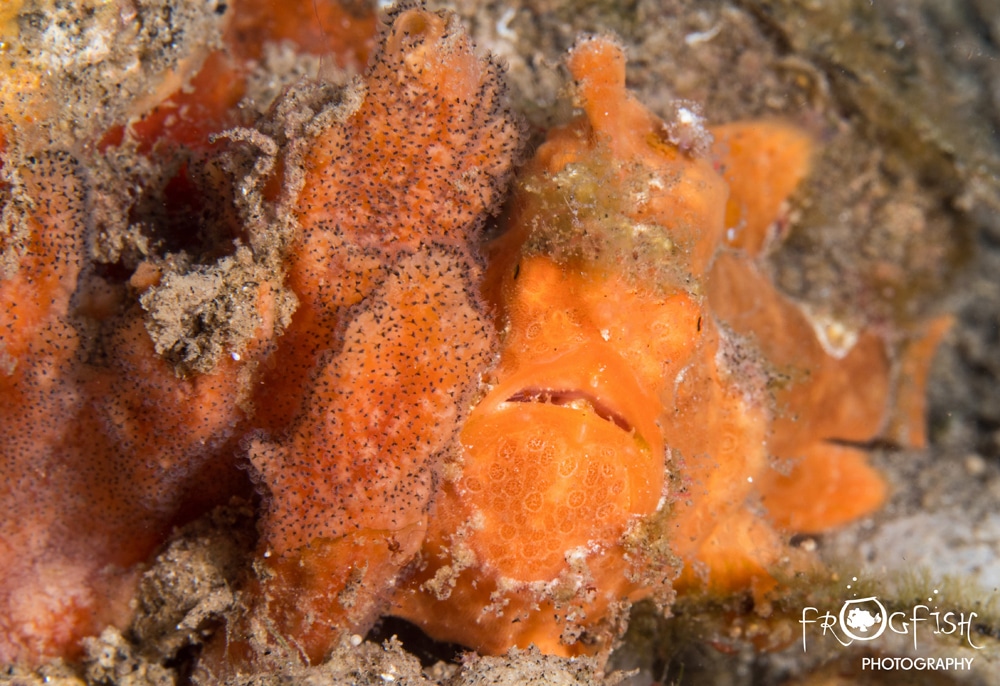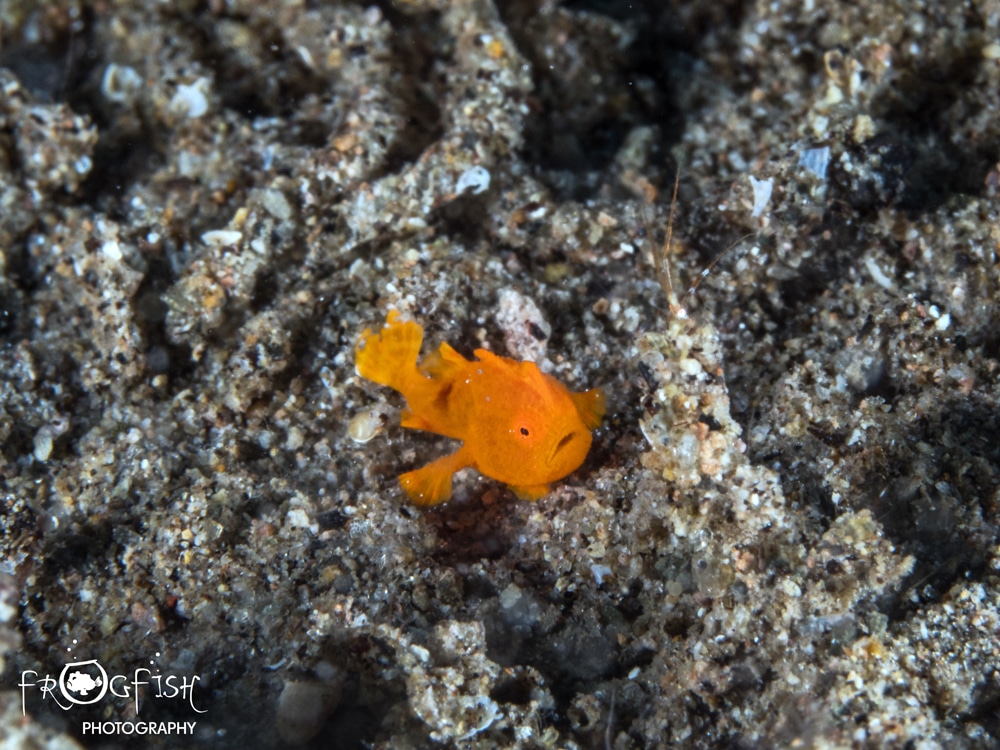News
Love Frogfish? Then you will love Atmosphere!

Love Frogfish? Yes? Then you are going to love Atmosphere Resort & Spa! Located in Dauin, on the island of Negros Oriental near Dumaguete, in The Philippines, this is frogfish heaven. Whether you are diving the famous Apo Island, with its wonderful coral reef (more on this another time) or exploring the local reefs and muck dives, there are frogfish wherever you look. This is the capital of the world for Frogfish.
We love frogfish so much, we named our company after them. So, it was with some excitement that we headed to Atmosphere, as not only did we know that we would be spending lots of time with our favourite weird fish, but Atmosphere has another treat for all frogfish fans – a resident expert – Daniel Geary (or Dr Frogfish)!
 Daniel wrote the PADI Frogfish Specialist Course and teaches it exclusively at the resort. The course starts with a two hour classroom session. Daniel goes into detail about the history of frogfish, such as the first ever drawings/encounters written in history, working our way up to the present and highlighting some of the important scientists that furthered our knowledge of frogfish.
Daniel wrote the PADI Frogfish Specialist Course and teaches it exclusively at the resort. The course starts with a two hour classroom session. Daniel goes into detail about the history of frogfish, such as the first ever drawings/encounters written in history, working our way up to the present and highlighting some of the important scientists that furthered our knowledge of frogfish.
He talks about general frogfish biology on subjects such as body morphology, predation, reproduction, movement, and distribution. The final topic is the identification segment, and, according to Daniel, that is the most important part of the course. He goes through a few main species in heavy detail, then talks about some of the rare species in moderate detail, touching on the super rare species just to show they exist and to see cool photos.
The course is centred around Indo-Pacific frogfish, but he can add frogfish from anywhere to tailor it to the diver taking the course. Participants then go for two dives, with the dive site chosen depending on the abundance of frogfish at that time of the year.
Daniel says: ” Normally we see between 2 and 5 species. We can expect anywhere from 1 to 30 frogfish during a course. My record is 36. During the dives themselves, our main objective is to locate the frogfish. We then measure them, take notes of habitat and any behaviour observed, and if brave, the students can guess identification underwater using hand signals. I bring my camera, and students are encouraged to bring theirs, so that we can properly identify the frogfish after the dive.”
After the second dive, the students have a debriefing session where they go through the photos. As a team, with the students leading, we identify each frogfish we spotted and look at their behaviour as well. The objective is for the students to identify the frogfish with minimal help. After the course, they get a free t-shirt, PADI certification, and a pdf file of Daniel’s custom Frogfish of the Visayas ID Guide.
Alas, there was not enough time on our trip for us to complete the Frogfish Specialist Course, but we did attend one of Daniel’s talks on his favourite subject of Frogfish, which are a popular evening event. We got to hear first-hand about his passion for frogfish, see some of his impressive images and learn plenty more about them, whilst sipping on a cool beer, after a great day of diving.
The diving was a real treat, and whilst we took in far more than just frogfish on this trip (more about this soon) it was amazing just how many different species and individual frogfish we encountered, from the miniscule ones, barely bigger than a grain of sand, to the very large ones camouflaged against sponges. Frogfish are incredible fish, with the ability to blend in to match their surroundings and then strike at their prey with ferocious speed. They use a special appendage to “fish” for their prey, dangling a lure out in front of their mouths. They tend to walk along the seabed and look clumsy when trying to move from one place to another. Be careful – they can become an obsession!
For more information please follow the links below:
The Official UK Travel Guide for The Philippines
Underwater Photography Equipment Used:
- Olympus OMD EM-1 MKII with 60mm lens
- Nauticam housing
- INON Z-240 strobes
and
- Nikon D800 with 105mm lens
- Nauticam housing
- INON Z-240 strobes
News
Book Review: Fire on Monroe Bravo by Fred Lockwood

Fire on Monroe Bravo is the latest book in the Jack Collier series by Fred Lockwood. Our story begins with our lead characters, Jack and Sandro, owners of Marine Salvage & Investigation Company, arriving on the Monroe Bravo Oil & Gas Platform in the North Sea. Having secured a contract for their vessel the MV Stavanger to act as support ship to the platform for TransGlobal Oil, our protagonists are on a celebratory visit.
However almost as soon as they arrive a series of explosions rock the platform, causing huge damage, loss of life and the very real danger of a massive human, ecological and financial disaster.

As the danger mounts for both our heroes and the surviving workers, Jack and Sandro will have to escape the inferno, all while trying to save the platform and the men still trapped unable to help themselves.
The disaster sets the scene for the unfolding story lines following the fate of the platform and our main characters, the police investigation into a suspected terrorist act and the actions of TransGlobal Oil as they attempt to navigate the pubic outcry and financial repercussions.
In his eighth book, Fire on Monroe Bravo, Fred Lockwood delivers an explosive thriller, with plenty of above and in-water drama, and our heroes fighting for survival, what more can you ask for?
We thoroughly recommend this read and look forward to the next in the series. For more information about his book series, you can check out the reviews of his previous books here on Scubaverse.
- Title: Fire On Monroe Bravo
- Author: Fred Lockwood
- ISBN: 979-8325324536
Available in a paperback version and for Kindle from Amazon and book stores.
Blogs
Alonissos: The complete diving destination (Part 1)

In June we were incredibly fortunate to be invited to dive in Alonissos, a small Greek Island in the Sporades island chain located in the North Aegean Sea. While I have long been a big fan of the Greek Islands as a great holiday destination, I had not had the opportunity to do any diving on previous visits and Mike and I were extremely excited to see what Alonissos had to offer both above and below the surface!

The Sporades are easily accessible via the airport in Skiathos (the first island in the chain), which is served by Jet2 flights from all major UK airports from May through October. Numerous ferries and charter boats make island hopping from Skiathos Town a breeze. After an hour boat ride, the picturesque port of Patitiri was a wonderful introduction to Alonissos, where we were met by our gracious hosts Kostas of Albedo Travel and Dias of Alonissos Triton Dive Center. Mike and I were delighted to be staying at the Paradise Hotel, aptly named for its stunning views over the sea and great location for walking to the waterfront.

Alonissos is beautifully situated in the National Marine Park of Alonissos and the Northern Sporades, the largest marine protected area in Europe. The surrounding seas offer fabulous marine life, including incredibly rare species such as the Mediterranean monk seal. They boast deep walls covered in gorgonians and sponges, stunning topography with caverns, swimthroughs and pinnacles, and the first accessible ancient shipwreck from 500BC!

In locations where historical sites have been reported, the waters are largely restricted, but with collaboration between government, underwater archeologists and dive centres, incredible underwater museums are being created for a truly unique diving experience. Alonissos is home to the first of these, the Ancient Shipwreck of Peristera Accessible Underwater Archeological Site. The chance to dive into history (along with reports of healthy reef life and amazing underwater topography) meant Mike and I were keen to get in the water.

Our introduction to the diving around Alonissos was at the Agios Georgios Pinnacles, in the channel between Alonissos and Skopelos. This fantastic site was named “The Chimney,’ and proved to have a huge amount to see. We got to a decent depth here (over 25m), and marvelled at a colourful reef wall with a wonderful swim through whose rocky walls were absolutely covered with life. As well as brilliant topography there was no shortage of macro life here. We saw numerous nudibranchs, five different species in total. The second dive at Mourtias reef nearby was a shallower dive along a nice wall with lots of crevices. Several moray eels and grouper called this site home. We enjoyed looking in the crevices for lobster and smaller benthic life, such as cup corals and tunicates.

Our itinerary allowed us two dives a day with afternoons left to explore the island with our hire car and evenings to enjoy the famous Greek hospitality. This proved to be a lovely mix of in-water and land based diversions.

The next days diving to the Gorgonian Gardens and Triton’s Cave was to be even better! These two stunning sites are nothing short of fabulous. The Gorgonian Gardens was a deep wall near to the Agios Georgios islands. The ever-present currents in this deep channel meant that the sea life was amazing … the namesake Gorgonian sea fans dotted the wall at a depth of 30 to 50 meters, getting ever larger the deeper we went. Above 30m was by no means less beautiful, with sponges, corals, scorpionfish, moray eels and some rare and colourful nudibranchs.

The second shallower dive of the day was to Triton’s Cave or the Cavern of Skopelos, on the east side of that island. The spectacular rock formations had wild striations both above and below the water making a truly epic topography. The cavern entrance was at 14m, and big enough for a buddy pair, winding up to 6m and passing two beautiful windows out into the blue. Emerging from the cavern, the light at the shallower depths and the incredible rock formations made for a fantastic gentle swimming safety stop and we all surfaced by the boat with massive grins.

Check out our next blog :Alonissos: The complete diving destination (Part 2)” to hear about our amazing dive on the 2500 year old Peristera Wreck!
Thanks to:
Alonissos Triton Dive Center https://bestdivingingreece.com/
Albedo Travel https://alonissosholidays.com/activities/
Paradise Hotel https://paradise-hotel.gr/
Alonissos Municipality https://alonissos.gr/en/
-

 Blogs2 months ago
Blogs2 months agoDiving With… Nico, Ocean Earth Travels, Indonesia
-

 News1 month ago
News1 month agoMurex Bangka Announce New Oceanfront Cottages & Beachfront Dining
-

 Blogs2 months ago
Blogs2 months agoA new idea in freediving from RAID
-

 Marine Life & Conservation1 month ago
Marine Life & Conservation1 month agoIceland issue millionaire whale hunter a licence to murder 128 vulnerable fin whales
-

 Marine Life & Conservation2 months ago
Marine Life & Conservation2 months agoThe Shark Trust Great Shark Snapshot is back
-

 News3 months ago
News3 months agoCharting New Waters; NovoScuba Goes Global with the Launch of their Revolutionary Dive Training Agency!
-

 Gear News1 month ago
Gear News1 month agoNew Suunto Ocean – a dive computer and GPS sports watch in one for adventures below and above the surface
-

 Marine Life & Conservation Blogs2 months ago
Marine Life & Conservation Blogs2 months agoBook Review: Plankton


















